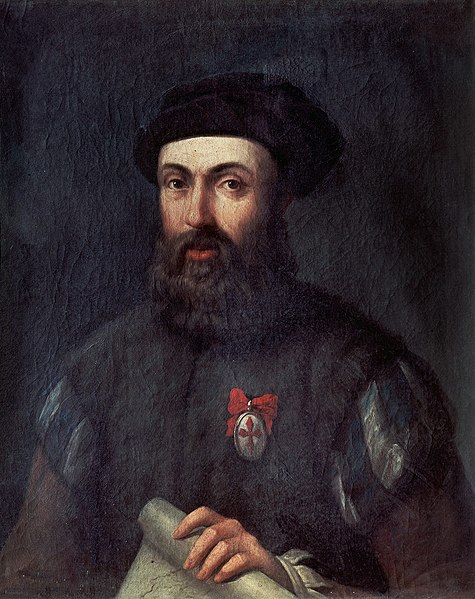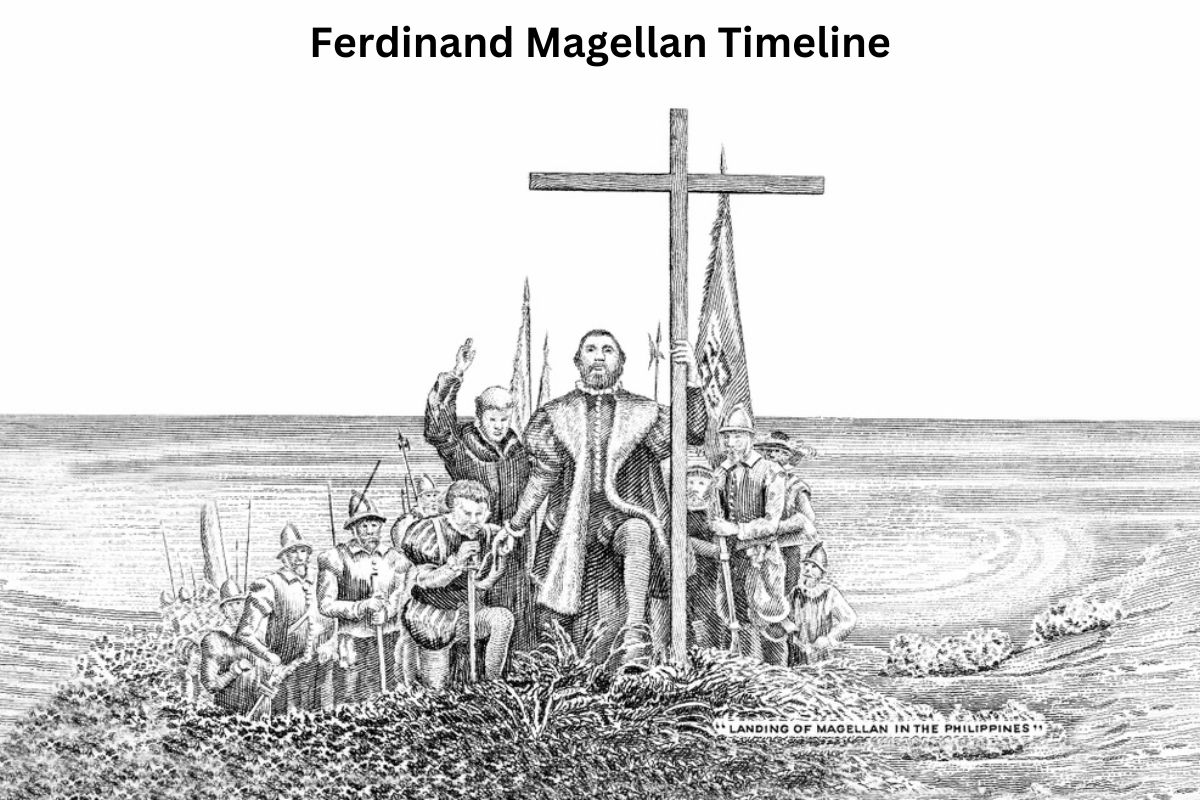Ferdinand Magellan, born around 1480, was a Portuguese explorer who is best known for leading an expedition from Spain in 1519 that eventually resulted in the first circumnavigation of the Earth.
Although Magellan himself did not complete the entire journey, as he was killed during a conflict in the Philippines in 1521, his expedition provided valuable proof that the world was round.
His fleet of five ships embarked on a westward journey to reach the Spice Islands, with only one ship, the Victoria, returning to Spain in 1522.
His voyage revolutionized understanding of world geography and ushered in an era of intensified global exploration.
| Year | Event |
|---|---|
| 1480 | Ferdinand Magellan was born in Sabrosa, Portugal. |
| 1495 | Became a page to the Queen of Portugal, Leonor. |
| 1505 | Started his seafaring career, joining a Portuguese fleet to the Indian Ocean. |
| 1509 | Participated in the Battle of Diu. |
| 1511 | Contributed to the Portuguese conquest of Malacca. |
| 1512-1513 | Was injured in Morocco and accused of illegal trading, leading to his dismissal from service. |
| 1517 | Moved to Spain to seek support for an expedition to the Spice Islands. |
| 1519, August 10 | Commissioned by King Charles I of Spain to find a westward route to the Spice Islands; set sail from Seville with the Armada de Molucca. |
| 1520, November | Reached the strait at the southern end of South America, later named the Strait of Magellan. |
| 1520, November 28 | Entered the Pacific Ocean. |
| 1521, March | Arrived at the island of Homonhon in the Philippines. |
| 1521, April 27 | Killed in the Battle of Mactan in the Philippines. |
| 1522, September 6 | The ship Victoria, under Juan Sebastián Elcano, returned to Spain, completing the first circumnavigation of the Earth. |
Timeline of Ferdinand Magellan
1. Born in Portugal around 1480
Ferdinand Magellan was born into a noble family in the small town of Sabrosa, Portugal. His parents were Pedro Ruy de Magalhães and Alda de Mezquita.
Being from a noble family, Magellan likely spent his early years at the family estate in northern Portugal, where he would have been introduced to various forms of education fitting his noble status.

2. Became a page to the Queen of Portugal in 1495
When he was around 15 years old, Magellan became a page to the Queen of Portugal, Leonor. This was a common practice for the sons of the Portuguese nobility, particularly for those who, like Magellan, were orphaned at a young age.
As a page in the royal court, Magellan would have been given responsibilities that taught him about the workings of the court.
Additionally, his education was broadened to include topics like cartography, astronomy, and navigation – subjects that would later prove invaluable to his career as an explorer.
3. Joined a Portuguese fleet to the Indian Ocean in 1505
In his mid-twenties, Magellan embarked on his career as a seafarer. He joined a large fleet of 22 ships, led by Francisco de Almeida, the first viceroy of Portuguese India.
Their mission was to set sail for the Indian Ocean, where they were tasked with establishing Portuguese outposts and securing trade routes in the East Indies. This would mark the beginning of Magellan’s life on the seas and his first experiences with exploration.
4. Participated in the Battle of Diu in 1509
Magellan took part in the Battle of Diu in 1509. This was a significant naval conflict where the Portuguese fleet, of which Magellan was a part, decisively defeated a coalition of forces that included the Ottoman Empire, Egypt, the Republic of Venice, the Sultanate of Gujarat, and the Zamorin of Kozhikode.
This victory was pivotal in establishing Portuguese control over the Indian Sea, which in turn played a crucial role in securing their monopoly over the lucrative spice trade.
5. Helped in the Portuguese conquest of Malacca in 1511
By 1511, Magellan was an experienced seaman. This year marked his participation in the Portuguese conquest of Malacca, on the Malay Peninsula, which was an essential trade hub on the route to the Spice Islands (the Moluccas).
The capture of Malacca under the leadership of Alfonso de Albuquerque demonstrated Portugal’s naval prowess and significantly bolstered the country’s control over important trade routes in the East Indies.
Magellan’s contributions during this campaign further honed his navigational and leadership skills, and he gained a better understanding of the Spice Islands’ location, which would become critical in his later expedition.
6. Injured in Morocco and accused of illegal trading in 1512-1513
Magellan joined a Portuguese expedition to Morocco in 1512, where he suffered a leg wound that caused him to limp for the rest of his life. It was during this time in Morocco that he was falsely accused of trading illegally with the Moors.
These accusations tarnished his reputation, and he fell out of favor with the Portuguese king, Manuel I. Despite his attempts to clear his name, Magellan’s service in the Portuguese navy ended with this disgrace.
7. Moved to Spain in 1517
Unable to continue serving Portugal due to the false accusations, Magellan left his homeland around 1517 and moved to Spain.
His intention was to convince the Spanish monarchy to back his plan of reaching the Spice Islands (the Moluccas), not by going east around the Cape of Good Hope – a route that Portugal controlled – but by going west, across the Atlantic and around or through the New World.
He believed that the Spice Islands lay within the Spanish zone of the Treaty of Tordesillas (a 1494 agreement dividing the newly discovered lands outside Europe between Portugal and Spain) and hence sought Spanish support.
8. Commissioned by King Charles I of Spain to find a westward route to the Spice Islands in 1519
After nearly two years of negotiation and preparation, Magellan’s proposal gained the support of the young Spanish king, Charles I (later known as Charles V, Holy Roman Emperor). King Charles commissioned Magellan to find a westward route to the Spice Islands.
His fleet, named the Armada de Molucca, was composed of five ships—the Trinidad, San Antonio, Concepcion, Victoria, and Santiago—and 270 men. They set sail from Seville, marking the beginning of one of the most famous expeditions in human history.
9. Reached the Strait of Magellan in 1520
After more than a year of sailing and searching for a westward path to the Pacific, Magellan’s fleet reached the strait at the southern end of South America. This strait, later named the Strait of Magellan in his honor, was a treacherous 373-mile passage linking the Atlantic and Pacific oceans.
The journey through the strait was perilous and cold, taking about a month to navigate. One ship, the Santiago, had already been wrecked during a scouting mission, and another, the San Antonio, deserted the fleet during the passage and returned to Spain.
10. Entered the Pacific Ocean in November 1520
After successfully navigating through the strait, Magellan’s reduced fleet of three ships entered a body of water he named “Mar Pacifico” because of its apparent calmness relative to the Atlantic. However, crossing the Pacific Ocean proved to be a long and arduous journey.
The crew had to endure extreme conditions including starvation, scurvy, and storms. Despite its initial calmness, the Pacific crossing was far longer and more perilous than Magellan had anticipated.
11. Arrived in the Philippines in March 1521
The fleet reached the island of Homonhon in the Philippines after approximately three months of crossing the Pacific. Here, they made contact with local inhabitants and began to establish relations.
However, tensions quickly arose between the Europeans and the local islanders, which would later escalate into open conflict.
12. Killed in the Battle of Mactan in the Philippines in April 1521
After having navigated their way through several Philippine islands, Magellan became involved in a local conflict in Mactan, pledging his support to a friendly local ruler against Lapu-Lapu, a chieftain of Mactan Island.
During the Battle of Mactan, Magellan was killed by a poisoned arrow. After his death, the fleet was left without its experienced leader, and command eventually fell to Juan Sebastián Elcano.
13. His remaining crew completed the first circumnavigation of the Earth in 1522
After more than a year since Magellan’s death, and after further navigational challenges and hardships—including surviving a siege in the Spice Islands, circumnavigating the Indian Ocean, and sailing around the Cape of Good Hope—the remaining crew members of the original fleet arrived back in Spain aboard the Victoria, the sole surviving ship.
Their arrival marked the completion of the first circumnavigation of the Earth, demonstrating conclusively that the world was round and that the Americas were separate from Asia.
